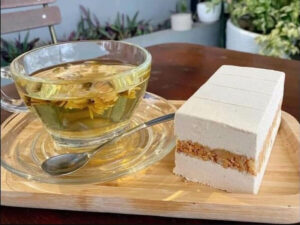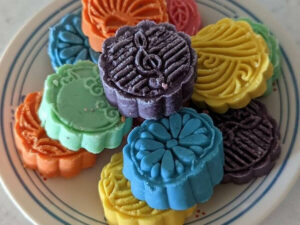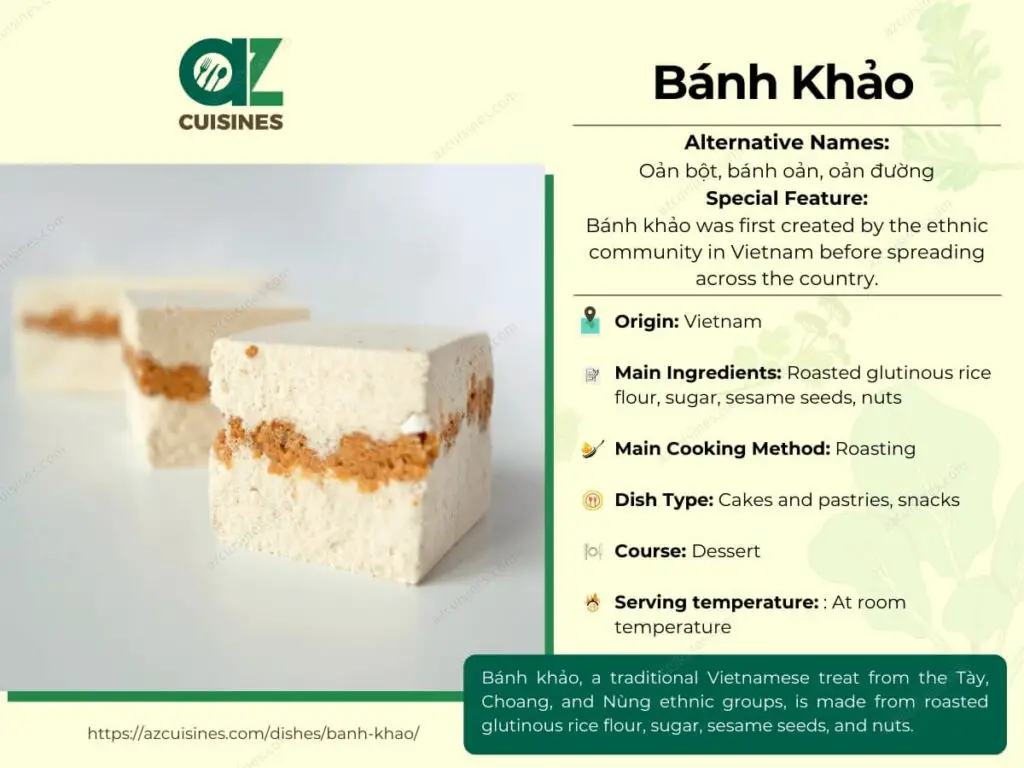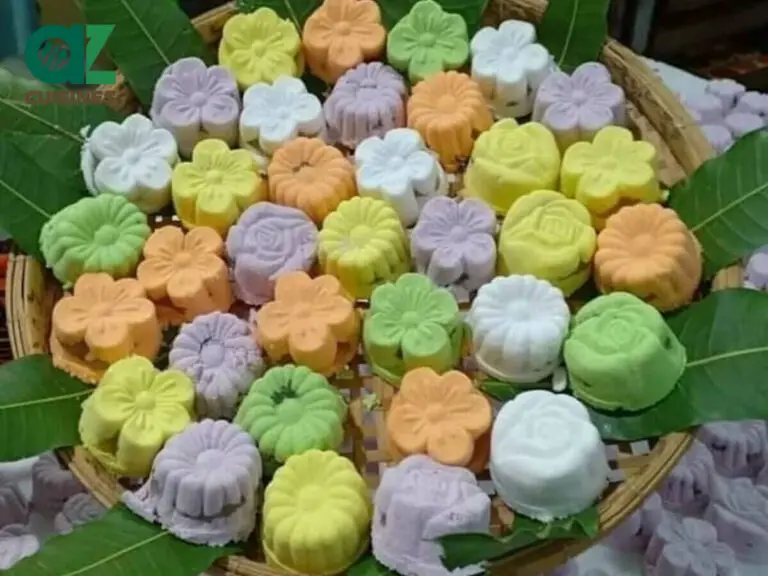#114 in Vietnam
Bánh Khảo: Basic Information
Pronunciation
Alternative Name(s)
Dish Type
Course
Mealtime
Popular Bánh Khảo Variations

Bánh In

Bánh Phục Linh

Bánh Khảo Cao Bằng

Bánh Khảo Tràng Định
Bánh Khảo: Ingredients and Preparation
Main Ingredients
Main Cooking Method
Preparation Process
Bánh Khảo: A Deep Dive
Cultural Significance
Taste
Texture
Aroma
Color
Serving Style
Serving Temperature
Accompaniment
Occasions
Seasons
Special Diets
Calories
Popularity
Popular Similar Dishes
- Klepon
- Halva
Popular Dining Area
Bánh khảo is a traditional Vietnamese rice treat originating from the Tày, Choang, and Nùng ethnic people in the country. In the Tày language, the word khảo means rice, but this dry treat actually makes use of roasted glutinous rice flour with sugar, sesame seeds, and aromatic nuts.
Typically, a traditional block of bánh khảo needs to go through a laborious process of roasting the rice, grounding, and sugar pounding before forming the filling and outer layer. Then, the two elements are incorporated into a mold to create bánh khảo.
Once this treat arrived in Kim Long village in Hue, the Vietnamese people called it bánh in and the cake later on became a favorite across the country. In the Northern region of Vietnam, bánh khảo is usually an offering item at temples, shrines, Tết events, and ceremonies.
Don’t forget to fully uncover the variations of bánh khảo along with all the side options for enjoying the cake and the advantages and disadvantages of it.
Then, take your time to find out about the common concerns relating to bánh khảo and some suggestions for specialties that are just like it.
Key Points
Bánh Khảo Images
What Are the Different Versions of Bánh Khảo?
Bánh khảo spreads to many regions outside of small ethnic groups, thus resulting in many adaptations of this glutinous rice cake:

Bánh Khảo Tràng Định
A regional variant from Trang Dinh, Lang Son in Vietnam
Made by the Tày and Nùng ethnic groups in the area to be a gift during Tết

Bánh Khảo Cao Bằng
A regional variant from Cao Bang
Often made for Tết events

Bánh Phục Linh
Similar to bánh in but made solely from dough and without any filling.

Bánh In
A renowned version of bánh khảo in Vietnam, coming from Hue
Made in rectangular or round shapes
Having explored the diverse regional variations of bánh khảo, each with its unique twist, let’s now shift your focus to the accompaniments that pair well with this sweet cake.
What Dishes to Pair with Bánh Khảo?
As a sweet treat, bánh khảo is best with items that compensate for its profile, bringing the overall experience to a perfect balance. Here are 4 popular options to try with bánh khảo:

Tea
A pot of hot tea, especially green tea or jasmine tea, is a classic accompaniment. The slight bitterness and warmth of the tea can balance the sweetness of the cake.

Coffee
Vietnamese coffee, either hot or iced, can be a great beverage to enjoy with bánh khảo. The strong, slightly bitter taste of the coffee pairs well with the sweet cake.

Nut mixes
A mix of unsalted or lightly salted nuts can offer a crunchy contrast to the soft, chewy texture of the cake.

Sinh tố
Fresh fruit juices made into a smoothie provide a refreshing touch while enjoying the dry profile of bánh khảo.
Knowing about items that go with bánh khảo is only one side of the story since it’s important for anyone to know about the features that decide whether this cake is suitable for your consumption.
Pros and Cons of Eating Bánh Khảo
These are the good and bad features that influence people who are looking to consume bánh khảo:
Pros
Cons
Next, explore the bánh khảo common concerns that allow you to delve deeper into the nuances of this traditional delicacy.










Truc Tran (Kris)
Senior Food Editor
Expertise
Home Cooking, Meal Planning, Recipe Development, Baking and Pastry, Food Editor, Cooking-video Maker, Vietnamese Food Evaluation Expert
Education
Truc Tran (Kris), an experienced food writer and editor, is great at exploring and describing global cuisines, from simple street food to fancy dining. In her writing, she skillfully mixes different flavors, cooking methods, and culinary traditions, showing the unique character of various cultures through their food and drinks. On azcuisines.com, Kris highlights her knowledge, especially in Asian cuisine and worldwide traditional dishes.